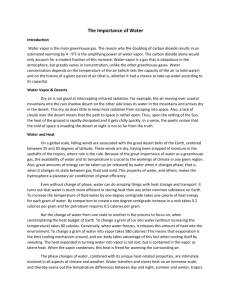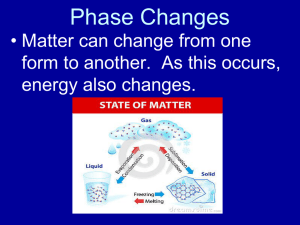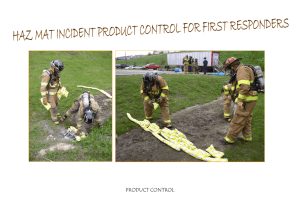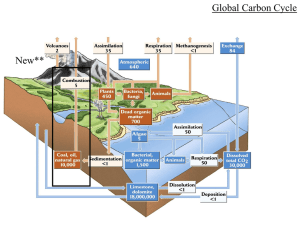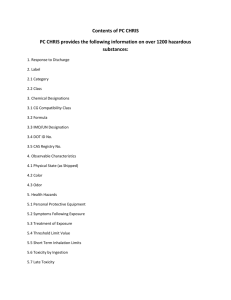Key
advertisement
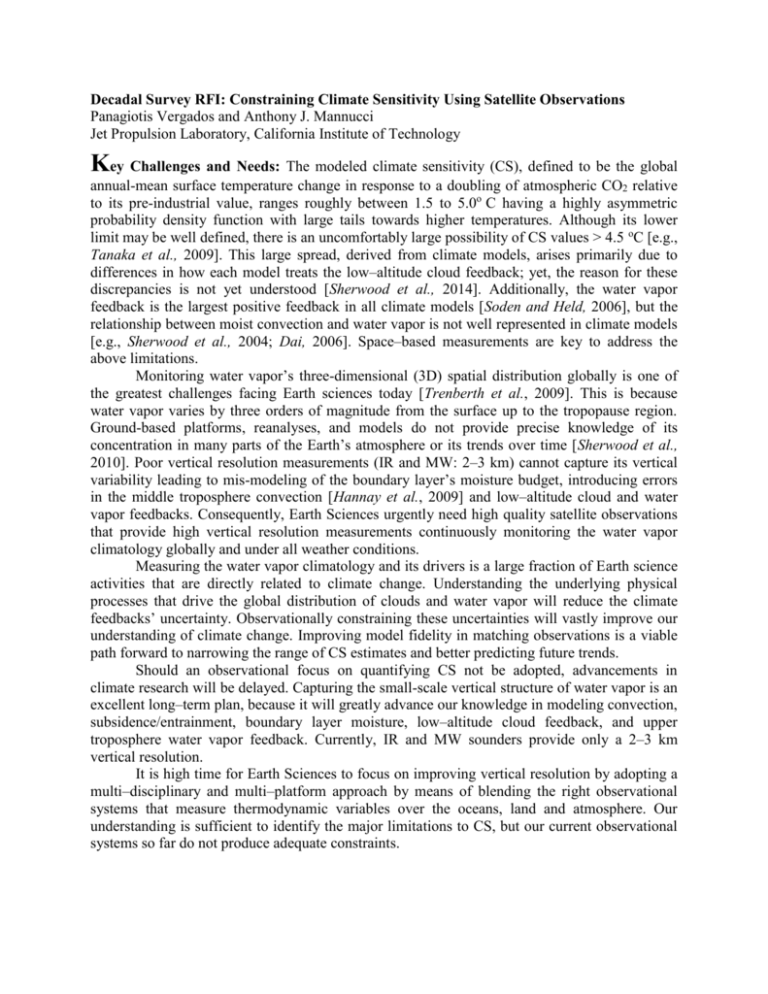
Decadal Survey RFI: Constraining Climate Sensitivity Using Satellite Observations Panagiotis Vergados and Anthony J. Mannucci Jet Propulsion Laboratory, California Institute of Technology Key Challenges and Needs: The modeled climate sensitivity (CS), defined to be the global annual-mean surface temperature change in response to a doubling of atmospheric CO2 relative to its pre-industrial value, ranges roughly between 1.5 to 5.0o C having a highly asymmetric probability density function with large tails towards higher temperatures. Although its lower limit may be well defined, there is an uncomfortably large possibility of CS values > 4.5 oC [e.g., Tanaka et al., 2009]. This large spread, derived from climate models, arises primarily due to differences in how each model treats the low–altitude cloud feedback; yet, the reason for these discrepancies is not yet understood [Sherwood et al., 2014]. Additionally, the water vapor feedback is the largest positive feedback in all climate models [Soden and Held, 2006], but the relationship between moist convection and water vapor is not well represented in climate models [e.g., Sherwood et al., 2004; Dai, 2006]. Space–based measurements are key to address the above limitations. Monitoring water vapor’s three-dimensional (3D) spatial distribution globally is one of the greatest challenges facing Earth sciences today [Trenberth et al., 2009]. This is because water vapor varies by three orders of magnitude from the surface up to the tropopause region. Ground-based platforms, reanalyses, and models do not provide precise knowledge of its concentration in many parts of the Earth’s atmosphere or its trends over time [Sherwood et al., 2010]. Poor vertical resolution measurements (IR and MW: 2–3 km) cannot capture its vertical variability leading to mis-modeling of the boundary layer’s moisture budget, introducing errors in the middle troposphere convection [Hannay et al., 2009] and low–altitude cloud and water vapor feedbacks. Consequently, Earth Sciences urgently need high quality satellite observations that provide high vertical resolution measurements continuously monitoring the water vapor climatology globally and under all weather conditions. Measuring the water vapor climatology and its drivers is a large fraction of Earth science activities that are directly related to climate change. Understanding the underlying physical processes that drive the global distribution of clouds and water vapor will reduce the climate feedbacks’ uncertainty. Observationally constraining these uncertainties will vastly improve our understanding of climate change. Improving model fidelity in matching observations is a viable path forward to narrowing the range of CS estimates and better predicting future trends. Should an observational focus on quantifying CS not be adopted, advancements in climate research will be delayed. Capturing the small-scale vertical structure of water vapor is an excellent long–term plan, because it will greatly advance our knowledge in modeling convection, subsidence/entrainment, boundary layer moisture, low–altitude cloud feedback, and upper troposphere water vapor feedback. Currently, IR and MW sounders provide only a 2–3 km vertical resolution. It is high time for Earth Sciences to focus on improving vertical resolution by adopting a multi–disciplinary and multi–platform approach by means of blending the right observational systems that measure thermodynamic variables over the oceans, land and atmosphere. Our understanding is sufficient to identify the major limitations to CS, but our current observational systems so far do not produce adequate constraints. Timeliness: In 2006 a GNSS radio occultation (GPSRO) constellation was launched – COSMIC – whose products are used in a wide range of atmospheric science applications such as weather forecast improvements, hurricane research, stratospheric temperature trends, and boundary layer meteorology [Mannucci et al., 2014]. GNSS RO observations offer refractive index profiles with unparalleled vertical resolution (~ 100 m), which contain temperature and water vapor information. Following on the success of COSMIC, in late 2016, another GNSS RO constellation will be launched offering even better quality refractive index profiles lower within the boundary layer, from which water vapor profiles can be retrieved. This fosters the perfect opportunity for the science community to begin exploiting the availability of such a wealth of high vertical resolution space–based observations. Why Space? Despite the availability of ground–based networks and campaigns, reanalyses, and models, without the availability of satellite observations there is no uniform sampling of the Earth’s atmosphere continuously globally. In particular, Yang et al. [2013] highlight the significance of using remote sensing observations to characterize processes and spatio–temporal states of the atmosphere, which have not been captured by climate models and conventional observing systems. Additionally, numerous authors try to estimate climate feedbacks using NASA’s A–Train low Earth orbiters (LEO) such as, AIRS [Gordon et al., 2013], MLS [Dessler et al., 2013], as well as NASA’s MERRA reanalysis [Dessler, 2013] to constrain the modeled feedbacks. Such efforts speak volumes about the importance of having space–based platforms to advance our current knowledge on climate change. Responses to the Questions: a. Is there a capability gap? The current capability gap in the Earth science community lies in the unavailability of high vertical resolution temperature and water vapor profiles globally and under all weather conditions. Understanding the Earth’s climate trends requires carefully integrated approaches that make maximum use of all available resources, not only for better predictions of future impacts, but also for better understanding of past and current observations. Should high vertical resolution thermodynamic atmospheric properties be meticulously blended with existing high horizontal resolution data sets, unique gridded products can be realized that can potentially observe atmospheric processes that are relevant to climate but have eluded study. In this context, and also in the context of planning and designing next-generation remote sensors to accommodate future observing requirements, high vertical resolution profiles and the development of mathematical methods for data fusion and optimal synthesis of present-day observations is a critically important need. Thus, Earth Sciences should explore multi–platform sounders, welcoming the use of complementary data products to successfully mitigate the emerging demands of climate change. This cannot happen without investments in new observing tools that span new regions of the electromagnetic spectrum (e.g., GNSS – Radio Occultations) currently underused for meeting Earth System Science objectives. b. Linking space-based observations with other observations. For example, the development of techniques to combine NASA’s A–Train space–based observations with GNSS RO signals for the retrieval of high spatial resolution global products is already underway. Such techniques are central to climate change research. c. Scientific and societal benefits. Easterling et al. [2000] discuss in detail how a change in climate increases the occurrence frequency of extreme weather events, while Knuttson et al. [2010] show that hurricane intensity will shift towards stronger categories in a warming climate. Evidently, better understanding CS is critical to devising strategic plans that help society evade future catastrophes with potentially high economic impact. For example, without the use of remote sensing observations, a hurricane cannot be “sensed” until it hits ground. Satellite observations can detect such events in advance and National Centers can announce forecasts to prepare the society. d. The science communities that would be involved. The science communities that would be involved in this goal are the GNSS radio occultation community, the climate modeling community, and scientists from tropospheric and stratospheric dynamics community. Here, we emphasize on the multi– disciplinary nature of CS bridging the modeling and observational communities. Testing the validity of a theory requires high quality observations, and this is the reason why we emphasize on the vertical structure of the water vapor profiles – because currently there are no space–based observing systems with the superior resolution of radiosondes (which are limited to coverage over land). References: Dai, A. (2006), Precipitation characteristics in eighteen coupled climate models, J. Clim., 19, pp. 4605–4630, doi:10.1175/JCLI3884.1. Dessler, A. E. (2013), Observations of climate feedbacks over 2000-10 and comparisons to climate models, J. Clim., 26, doi:10.1175/JCLI-D-11-00640.s1. Dessler, A. E., et al. (2013), Stratospheric water vapor feedback, PNAS, 110, doi:10.1073/pnas.1310344110. Easterling, D. R., et al. (2000), Climate extremes: Observations, modeling and impacts, Science, 289, doi:10.1126/science.289.5487.2068. Gordon, N. D., et al. (2013), An observationally based constraint on the water vapor feedback, J. Geophys. Res., 118, doi:10.1002/2013JD020184. Hannay, C., et al. (2009), Evaluation of forecasted southeast Pacific stratocumulus in the NCAR, GFDL, and ECMWF models, J. Clim., 22, doi:10.1175/2008JCLI2479.1. Knuttson, T. R., et al. (2010), Tropical cyclones and climate change, Nature Geoscience, 4, doi:10.1038/ngeo779. Mannucci, A. J., et al. (2014), Studying the atmosphere using global navigation satellites, EOS Trans., 95, doi:10.1002/2014EO430001. Sherwood, S. C. et al., (2010), Tropospheric water vapor, convection, and climate, Rev. Geophys., 48, RG2001, doi:10.1029/2009RG000301. Sherwood, S. C., et al. (2014), Spread in model climate sensitivity traced to atmospheric convective mixing, Nature, 505, doi:10. 1038/nature12829. Trenberth, K. E., et al. (2009), Earth’s global energy budget, Bull. Amer. Meteor. Soc., pp. 311–324, doi:10.1175/2008BAMS2634.1. Yang, J., et al. (2013), The role of satellite remote sensing in climate change studies, Nature Climate Change, 3, doi:10.1038/nclimate1908.


